
All My Stuff: What I Have In My Chinese Kitchen
Sometimes I think I’m the world’s worst expat. I live in China now (and before that, in Turkey and South Africa among other places) and yet I still insist on craving and cooking things that are utterly unChinese. If I was a decent human being, I’d immerse myself in Chinese cooking and teach myself how to wrangle tofu skins and beef tendon and jellyfish.
However, when I venture outside the flat, I get enough of that. At home, I want bread and dairy and egg noodles and stews involving Guinness and potatoes. I want chocolate cake. I want peanut butter cookies. I want garam masala and biryani. When I cook, I prefer to make comfort foods. In restaurants, I’ll try just about anything. This blog, as you may have gathered by now, is all about what I make at home. You will not see any chicken feet or bullfrog hotpot here.
Now, if you are a culinarily homesick laowai way out in the sticks, you may be quietly shouting at me, “Hey, you do realize that you live in Shanghai, which has a foreign population of approximately 200,000, most of them rather well-off and able to afford all the many import shops and international restaurants and fancy apartments kitted out with stoves and whatnot, right?”
Which is true. I’m spoiled rotten here, to a certain degree. I could buy, say, Bisquik buttermilk biscuit mix from City Shop, if I felt like spending an hour’s wages and making chemical-laden instant bread products. Same with ricotta cheese. It’s about 50rmb for a tiny tub. I can make the equivalent of two or three tiny tubs for half that cost and mine is better and fresher. I’m a food nerd and I want to be able to make my own things with what I have available here.
Our flat is still a very Chinese flat. We don’t live in a foreigner compound. We live in a Chinese building on a very Chinese street, with chickens and ducks being killed and skinned down on the sidewalk and flayed pigs hung out to dry and mounds of vegetables spread out on the sidewalks from dozens of tiny shop fronts. Our kitchen is basic, our tools are basic. I think most of what I make here could be replicated in, say, Chengdu or Wuxi or Urumqi.
Let me show you what we have.
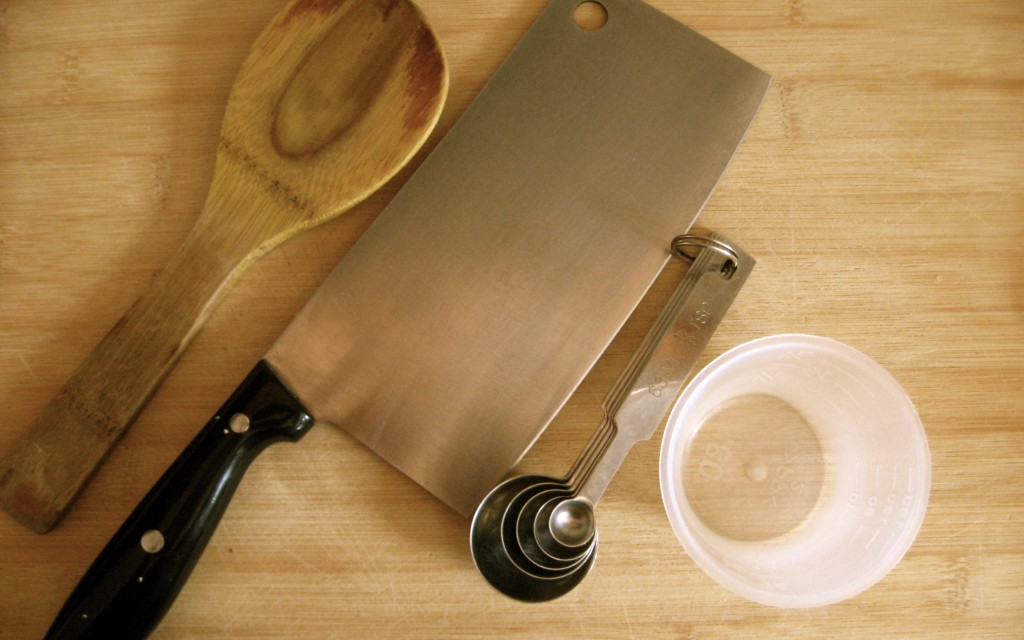
First of all, these are my basic tools. Since I went home for a few weeks in July, I’ve added a small rubber spatula and a set of multi-sized measuring cups to my collection, as well as two lengths of cheese cloth. However, the above are what I’d used for the two and a half years leading up to that visit. If you don’t have cheese cloth, just use thinly woven clean, undyed cotton. I’m sure a section of old bedsheet would work fine for draining cheese curds. One friend reported back to me that her cloth grocery bag worked just fine.
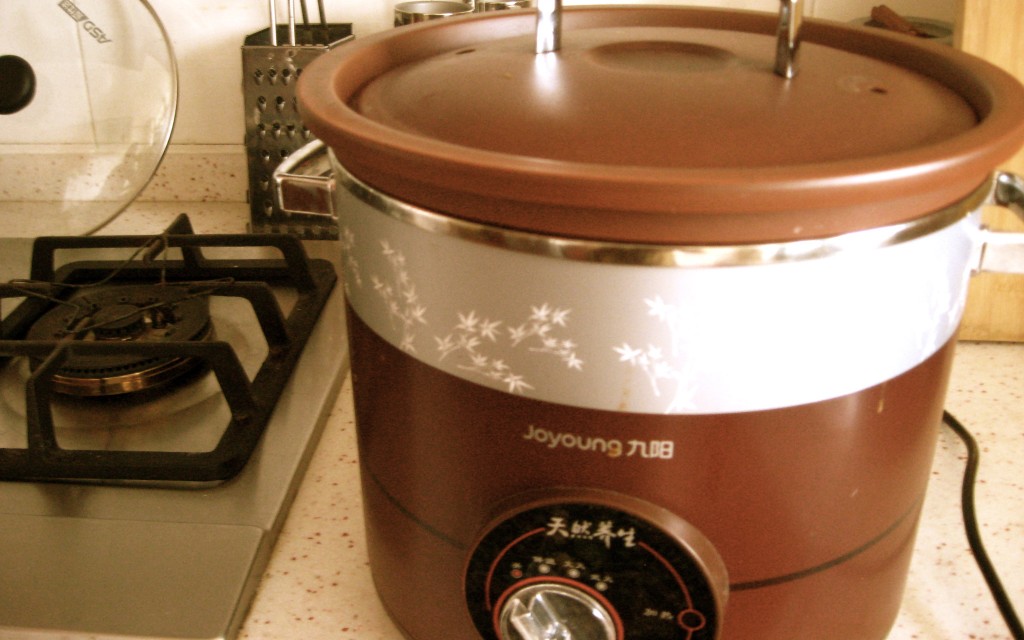
This is the slow cooker, which we bought about a year and a half ago. It isn’t a pressure cooker and it can’t be left alone to cook for long periods because the liquid will evaporate and stick. We use it for soups, stews, curries, pasta sauces, chili, dried beans.
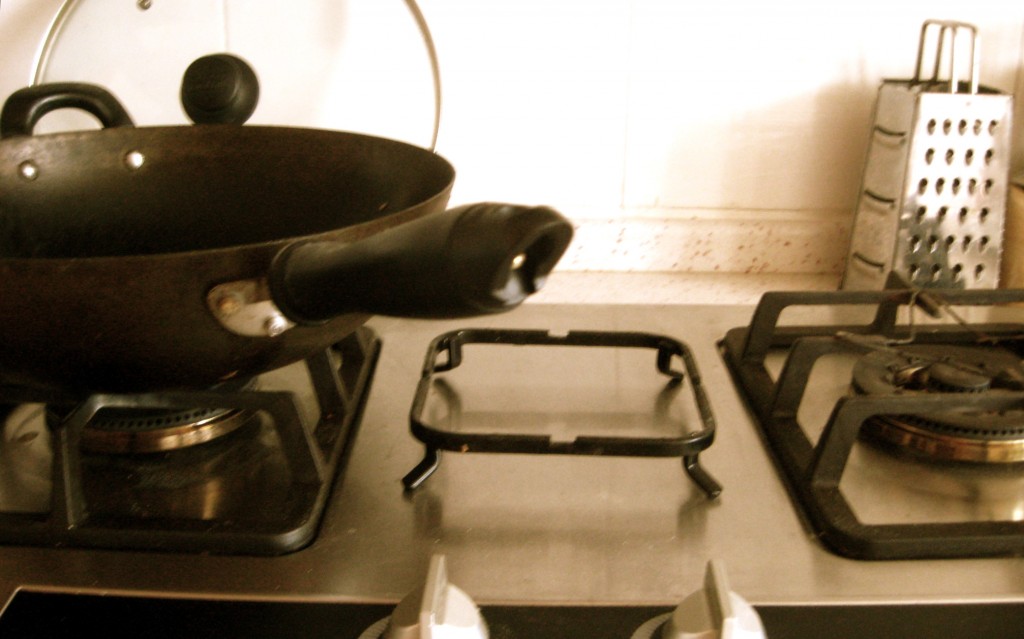
This is our stove. I bought the wok when I first moved here and was living by myself out in Pudong, in a flat with a kitchen even smaller and more basic than our current one. This wok was my only cooking pot for several months. I used it to boil noodles, to steam veggies, to sautee, to stew, to simmer. You can do pretty much anything in a wok if you set the gas flame level carefully. If you look at the right hand burner you can see a little star shaped wire contraption. My Dad made this just after I moved here and discovered that, unlike with Turkish gas stoves, the metal burners on Chinese gas stoves were too big and wide for an espresso maker to sit above the flame. The wire contraption is just that: some carefully bent wire. It does allow my espresso maker to not be engufed in flames though.
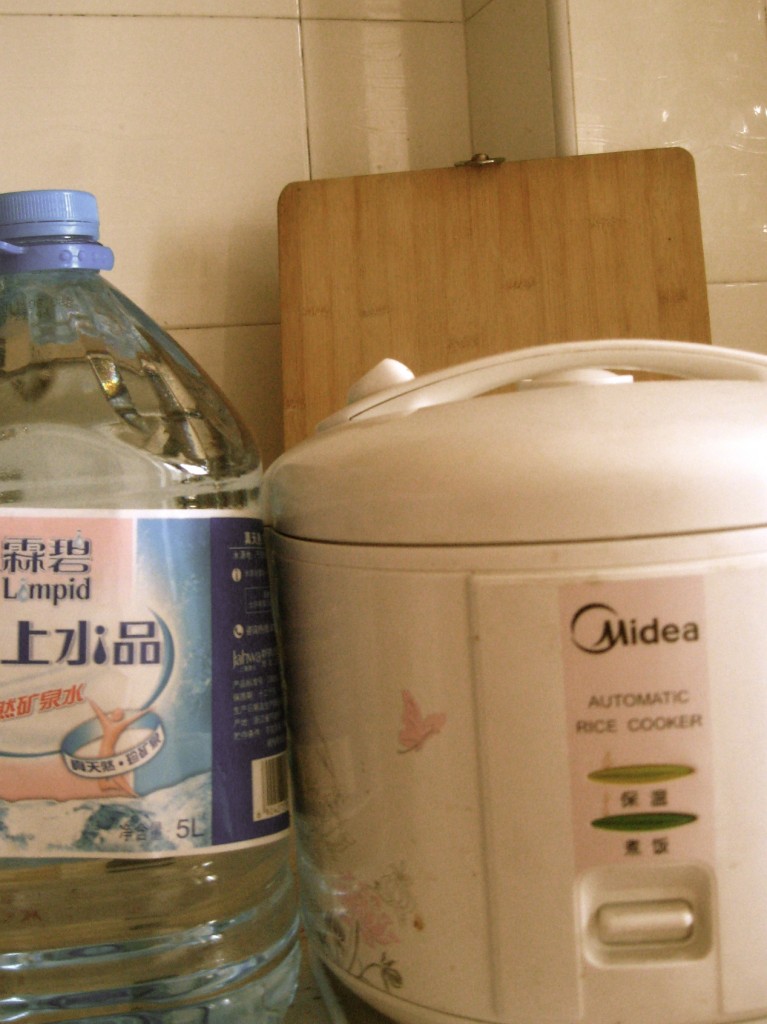
One of the things that drives me crazy here is the fact that the tap water is really not fit for drinking or cooking with. Even if I was brave enough to chug it back, it still tastes awful and metallic and rusty. We use it for boiling pasta and dried beans but not for anything that requires a neutral-tasting liquid. For soups, stews and other liquidy recipes, we use bottled water. The corner of our kitchen by the door usually houses two or three 5 litre bottles. For rice, we use the bottled water. This is our rice cooker. I’ve been told that some people have miraculous, complex ones that can bake bread and make cakes but ours… so far, I’ve made rice (white, brown, black and wild), grains (barley, whole oats, rye, quinoa) and breakfast cereal. It has two settings: full blast boil until cooked and maintain the heat after cooking.
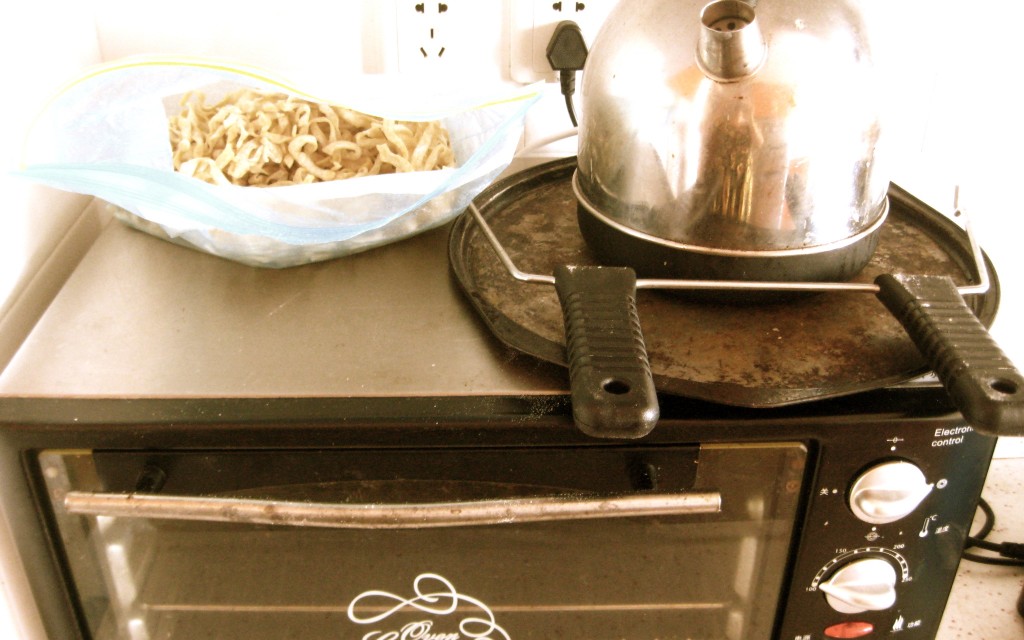
This is my oven. It’s small and is mostly a glorified toaster oven. It was a gift from a friend whose marvellous landlord promised her a new oven– a built-in oven. A real oven. The kind that could cook, say, a turkey or a pizza. This one is small and simple but effective. It has a few settings: top element, bottom element, both elements. It goes up to about 300 250 degrees C. There are a few other settings that I have yet to decipher. The baking sheet you see was a gift from my mother. Before I had that, I used the flimsy disposable baking pans I found in the supermarket here (which I carefully cleaned and reused until they were too crushed and cut and broken to keep going).
The kettle is just a cheap electric one I got at Carrefour a few years ago. The electrical connection doesn’t always work and I need to wiggle the cord around a bit to get it going.
All of the recipes that I’ll be posting here will be able to be replicated using this basic equipment. I sometimes use large saucepans for mixing flour. You can easily find these in most supermarkets. Hell, you could just go invest in a big bowl.
Any requests?
Easy Peasy Potato-Enhanced Chapatis!
Woks and Bagels!
You May Also Like

Easy Peasy Potato-Enhanced Chapatis!
September 15, 2011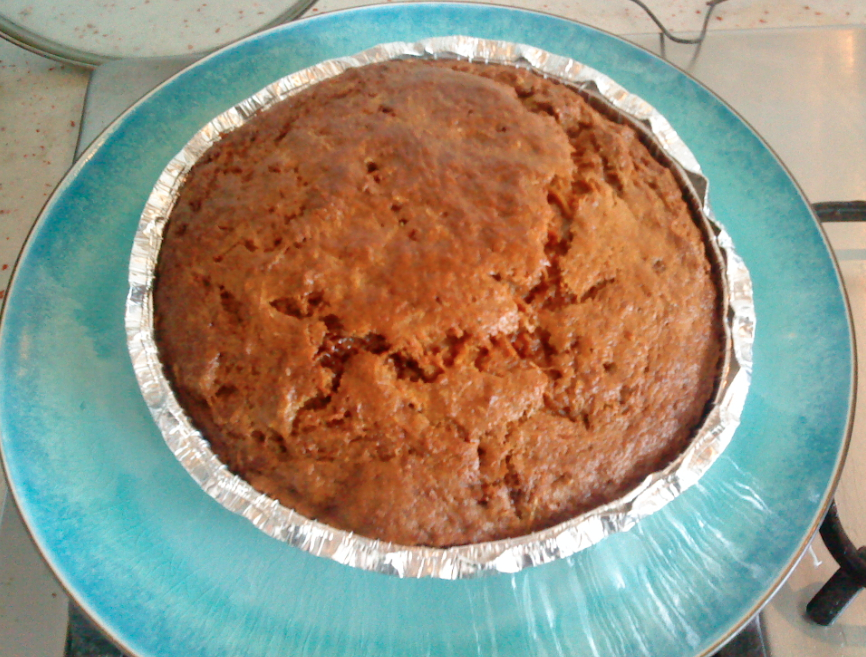
The Infamous Mega-Carrot Cake
December 22, 2011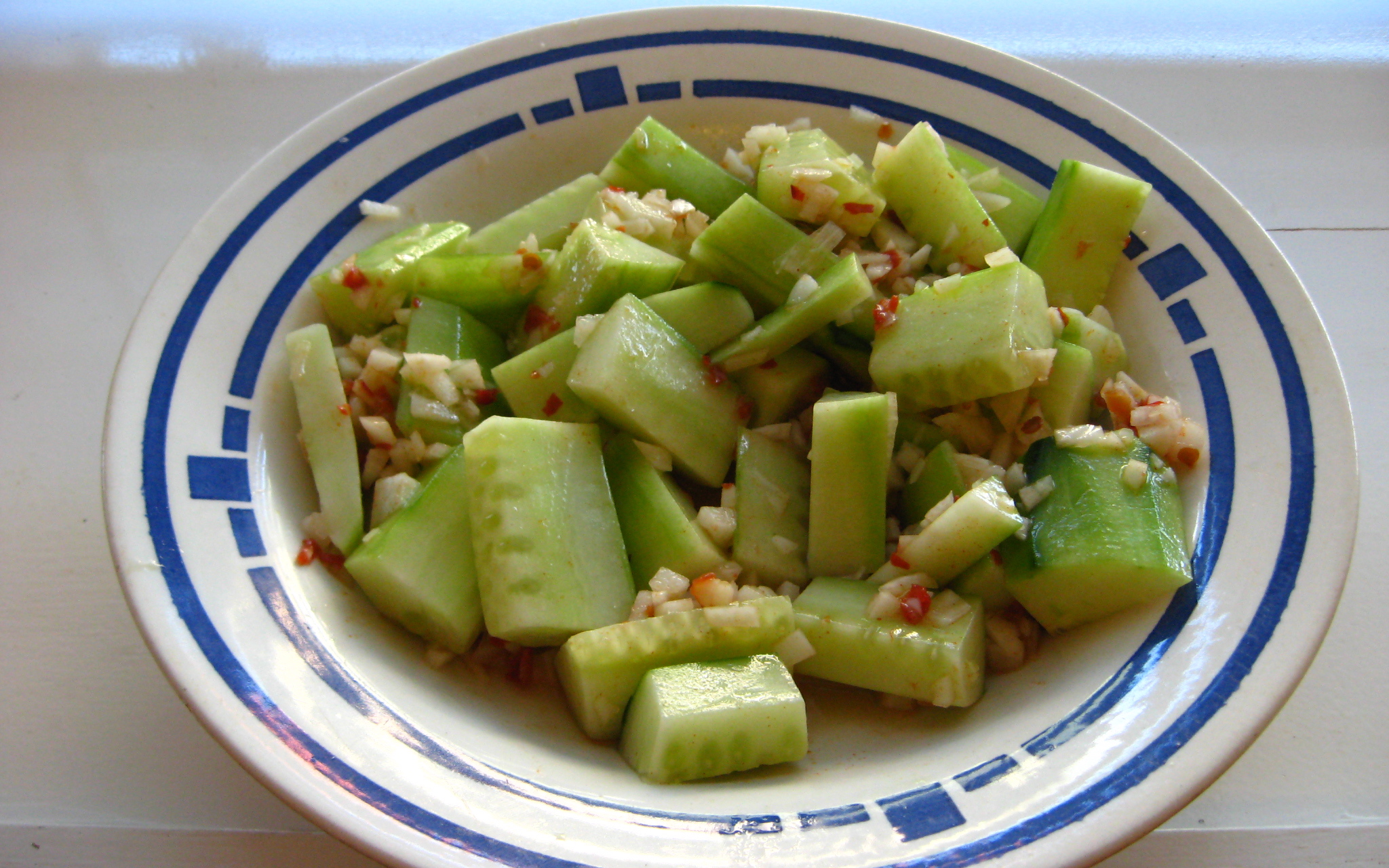
12 Comments
Steve
We’ve got a proper oven, but whilst the dial goes to 250C it doesn’t seem to get much hotter than ~200C. I massively improved it’s effectiveness by buying a 4 kuai terracotta tile to store up the heat, rather like a pizza stone.
Steve recently posted..Observations on London, after a year in China
MaryAnne
The stone is a great idea! To be honest, I doubt ours actually goes up to 300 degrees. It just says so on the dial. My last attempt at cake needed an extra 10 or so minutes tagged on to the recipe’s maximum time before the middle stopped being liquid. Is your tile glazed or matte? I thought about getting one too.
Steve
It’s just a plain, unglazed 40x40x0.8cm terracotta tile from a builders merchant. We found one with a slightly chipped corner so he knocked 2 off the price
Steve recently posted..Getting tired of being Civilised – Chaoyang, Beijing
Sarah
Your knife is MASSIVE.
My only request? Please be mindful of your fingers and thumbs when cutting your veggies!
Sarah recently posted..The Time I got a Rub-down by an Inmate in Chiang Mai
MaryAnne
Fear not! I am well versed in careful knife work! I have yet to accidentally slice off any appendages. I will, however, be extra careful for your peace of mind 🙂 (Also, I’ve found those big-assed cleavers to be easier to handle than smaller knives as they are more balanced, weighted, and have a bigger surface area to rest your curled-inward knuckles against when chopping so your fingers don’t end up under the blade).
TracyAnn0312
But it seems that the cooking stuff you have shared Mary Anne are quite very good to those people who love to cook. Thanks for the lovely photos you have.
Jacoby
There are no words to decsribe how bodacious this is.
Nicola @ unhip squirrel
Hey! I just found you through foodbuzz. Your blog is awesome!! What a great concept, and your posts are hilarious. I’m impressed that you made your own ricotta. I can’t wait to see what comes next!!
Nicola @ unhip squirrel recently posted..jalapeno popper inspired grilled cheese
MaryAnne
Awesome, thanks! I looked over at your blog and your first recipe just tugged at my heart: I mean, seriously- jalepeno popper grilled cheese sandwiches?! Wow. I think i may need to replicate that in my wok somehow…
(Hello from a fellow west coast art/history grad, by the way– I did my BA at U Vic majoring in Modern Chinese Revolutionary/Post Revolutionary cultural/art history. A real money maker, that one! My minor was comparative Commonwealth literature, which pretty much guaranteed me a job at Starbucks or, um, in China…)
Nicola @ unhip squirrel
Ha! Yeah… those arts degrees eh? I can totally relate. They’re fun, but they don’t get you very far. I’m cubicle dwelling. :-/
Nicola @ unhip squirrel recently posted..jalapeno popper inspired grilled cheese
Magnus
Love the new site. I found you on the Tribr that you and I on together… but this was a surprise. I love this post. I want to do a comic about it!
Magnus recently posted..M and Mx Radio: Lanterns, Poker Winnings and a Mooncake Mix
MaryAnne
Thank you! I love your comics. Would love to see what you can do with cake…